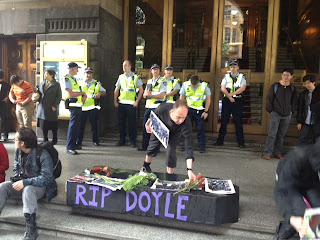 |
| A hoped-for political "funeral" for Doyle at Melbourne Town Hall |
Clouded by allegations he has refused to fully answer about campaign funding, an unrepentant Doyle again seeks the top job with a Federal Court judgment in the offing over whether the City of Melbourne and Victoria Police acted unlawfully and breached the rights of the protesters whose eviction he sought a year ago.
For the anniversary protesters, however, thoughts about Doyle’s continuing bid for power came with more humble reflections about what Occupy continues to represent.
Early on, a mere handful of people gathered near Spring Street on the lowest steps of State Parliament. Just a couple of Protective Services Officers patrolled their upper reaches, but there were no police save for a Critical Incident Response Team van that swung by and continued without apparent interest down Bourke Street.
Was this less the anniversary of a movement than its funeral parade? Would the scene be set for media coverage that would see the numbers as a vote for or against the value of Occupy as a whole?
A year on, with many of the global economic and social justice issues that have concerned the movement only worsening, and with the Sydney coronial inquest into the police tasering of Roberto Laudisio Curti, it would be a mistake to conclude that low numbers could possibly signal irrelevance.
Instead, they would, if anything, signal the challenge of sustaining a disparate movement amid what Noam Chomsky described in July as an “atomised society” where “people are kind of alone, and not by accident”.
Speaking to Gary Younge of The Guardian, Chomsky noted “very large-scale, coordinated, planned efforts to try to restore people to apathy and obedience”. Since Occupy, however, he said that activism had only grown. It was, Chomsky said, a movement of different aspects and strands.
And so it was last Sunday, as the small group at State Parliament was joined by a further group marching up Bourke Street, bearing a black cardboard coffin painted with the words “RIP Doyle” in a hopeful signal of the Lord Mayor’s political demise.
If a sign was sought of the movement’s continuing importance, it was seen in what followed, in the reaction of PSOs to a muted - indeed, funereal - protest on a quiet Sunday afternoon in Melbourne.
The PSOs conferred, radios were spoken into, and police began to gather - two vans at first, and five police officers standing aloof from protesters now lining Parliament’s upper steps with photographs and signs protesting police violence, the coffin at their feet as a funeral dirge floated mournfully in the air.
 |
| A PSO confers by radio upon the arrival of Doyle's coffin at State Parliament |
In this, the scene brought to mind Chief Commissioner Ken Lay’s comments about such protests distracting police from the prevention of robberies, burglaries and assaults. In what ill-conceived world is constraining peaceful protest a higher priority than such crimes? Was this in any sense meaningful law enforcement?
At the Town Hall the police numbers grew to eight, with five cars ranged along the kerb, across the road and around the corner. The coffin was laid beneath the very balcony where Doyle had witnessed the actions of police last year - the regular and special operations officers, the horses, and all the standard armoury now too often deployed towards compliance with police demands aligned questionably to the actual law.
There was a sadness at this protest, but not over its worth among the protesters. Instead, there was a pervasive sense that in a democracy police should not create confrontation in order to resolve it through the use of disproportionate and unnecessary force. We could have been mourning Roberto Laudisio Curti, or Tyler Cassidy.
 |
| The protest at a Flinders Lane police station is well-monitored by police and CCTV |
In the aftermath of the October 2011 eviction, Radio National’s World Today program reported one protester’s words about the state of modern society, if not all who live within it: “We’re trained to see differences between each other; we can’t see what makes us similar anymore”.
Fortunately, one year on from the Occupy Melbourne eviction, and on this day unshaken by police violence, we could be more hopeful. We could still see and share what joins us all.
-
Listen to Jon Faine speaking with Doyle about Occupy
This post represents my personal views. I did not attend the original Occupy protest evicted from City Square and do not speak for the Occupy movement. I have participated in a number of subsequent protests as an ordinary person supportive of Occupy's aims.